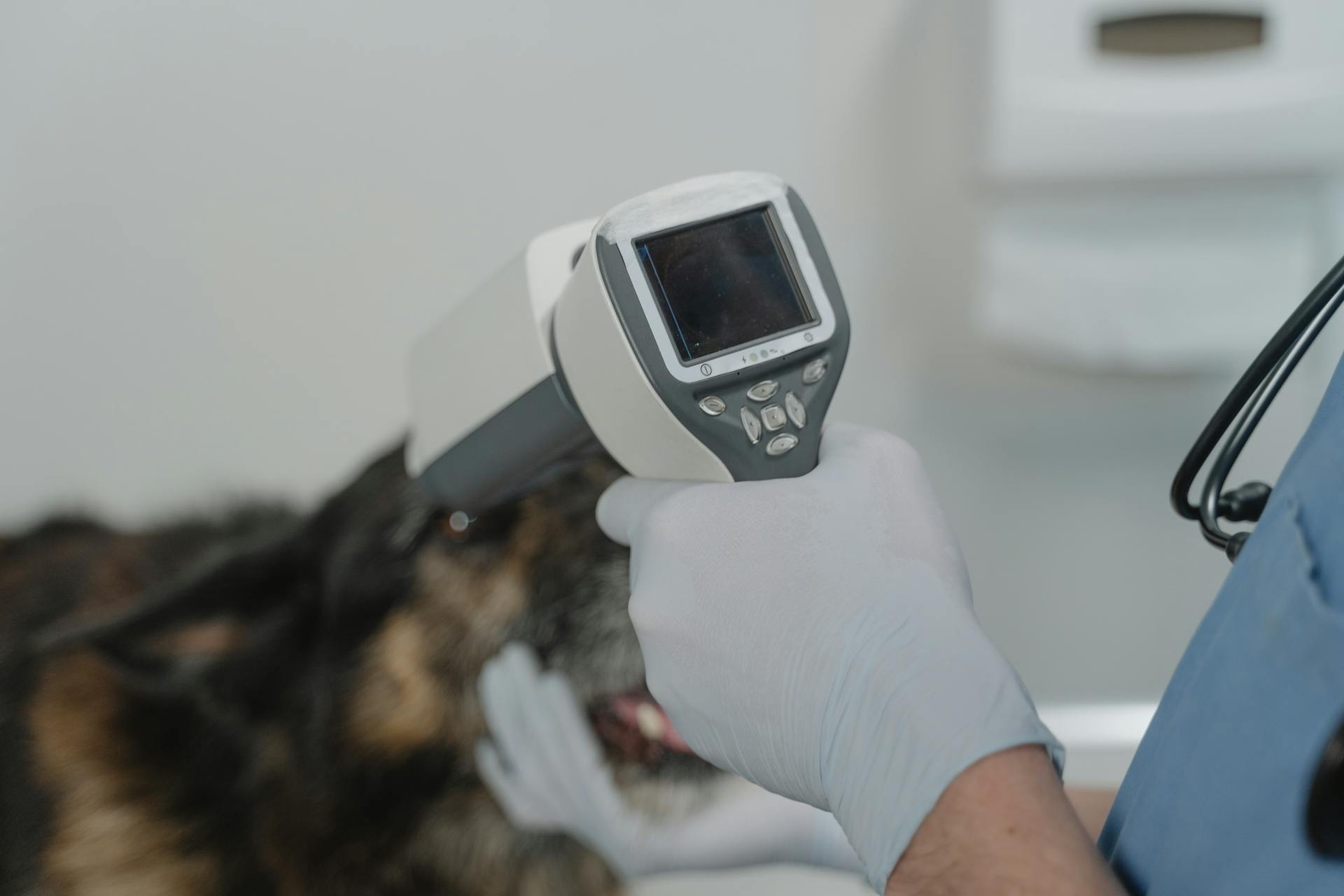
Canine lymphoma is a serious and often misunderstood disease that affects many dogs. Lymphoma is the most common type of cancer in dogs, accounting for 10-20% of all canine cancers.
The disease can progress rapidly, with some cases developing in as little as 2-3 weeks. Symptoms can be vague, making it difficult to diagnose, but common signs include lethargy, loss of appetite, and weight loss.
Early detection and treatment are crucial for improving a dog's quality of life and potentially increasing their lifespan. In some cases, lymphoma can be managed with chemotherapy, but the prognosis is generally poor.
When to Euthanize
Euthanizing your dog is never an easy decision, but it's essential to consider their quality of life. If your dog has a drastic decline in quality of life, despite exhausting every treatment option, it may be time to consider euthanasia.
Difficulty breathing is a major factor to consider, particularly if your pet suffers from lung or heart disease. The large lymph nodes can block the throat if your dog has end-stage lymphoma, making breathing even more challenging.
Readers also liked: How Long Can a Dog Live with Hemangiosarcoma without Treatment
Signs of pain are another crucial indicator. If your dog has already been given appropriate pain relief yet is still showing signs of being in pain, it may be time to consider euthanasia. Some dogs may not show obvious signs of pain, making it even harder to gauge when to say goodbye.
Here are some common signs of suffering in dogs:
- Unwilling to go on walks or move about the house
- Crying or whimpering
- General restlessness
- Sudden aggression towards other people or animals
- Accidents around the house when they have been toilet trained
- No appetite
- Sudden weight loss
- Unable to sleep
- Panting
- Becoming withdrawn and isolating themselves or becoming clingy
- Resenting being touched
- Obvious signs of pain, such as limping
Difficulty Breathing
Difficulty Breathing is a major concern when deciding whether to euthanize your dog.
If your pet suffers from lung or heart disease, difficulty breathing can be a significant factor to consider.
Large lymph nodes can block the throat, making breathing even more difficult, especially in dogs with end-stage lymphoma.
Breathing difficulties can be a sign that your dog's quality of life is severely compromised.
In such cases, euthanasia may be the most humane option to prevent further suffering.
8 Signs to Consider Before Euthanizing Your Dog
If your dog is struggling to keep up with treatments, it may be time to consider euthanasia. Some dogs may experience a drastic decline in quality of life, making every day a struggle.
If your dog has already been given appropriate pain relief yet is still showing signs of being in pain, it may be an indication it's time to consider euthanasia. This can be especially challenging if your dog is not showing obvious signs of pain.
Dogs can be very stoic, and some may not show any clinical signs of suffering, even if they're in pain. This can make it harder to gauge when it's time to say goodbye.
Here are some signs to look out for:
- Unwilling to go on walks or move about the house
- Crying or whimpering
- General restlessness
- Sudden aggression towards other people or animals
- Accidents around the house when they have been toilet trained
- No appetite
- Sudden weight loss
- Unable to sleep
- Panting
- Becoming withdrawn and isolating themselves or becoming clingy
- Resenting being touched
- Obvious signs of pain, such as limping
It's essential to consider your vet's input when making this difficult decision. They will be able to assess your dog's circumstances and the development and prognosis of the cancer, as well as any other factors that may contribute to your dog's health status.
Emotional Considerations
Emotional Considerations can be a significant challenge when dealing with canine lymphoma. It's normal to feel a deep emotional bond with your pet, which can sometimes hinder the decision to euthanize.
The decision to euthanize should always be made with your vet's input, as they can assess your dog's circumstances and the development and prognosis of the cancer. Your vet will consider any other factors that contribute to your dog's health status.
It's essential to reflect on your motivations for prolonging your pet's life. Ask yourself: Are you doing it for their sake or yours? This self-reflection can help you make a more informed decision.
Here are some signs that may indicate your pet is suffering:
- Unwilling to go on walks or move about the house
- Crying or whimpering
- General restlessness
- Sudden aggression towards other people or animals
- Accidents around the house when they have been toilet trained
- No appetite
- Sudden weight loss
- Unable to sleep
- Panting
- Becoming withdrawn and isolating themselves or becoming clingy
- Resenting being touched
- Obvious signs of pain, such as limping
Signs of Suffering in Dogs
Dogs can be very stoic, and it's not always easy to tell when they're suffering. Some may show obvious signs, while others may give no clue at all.
If your dog is experiencing cancer, they may not show any clinical signs if the cancer is not aggressive. However, if they do show signs, they can be subtle and easy to miss.
Some common signs of suffering in dogs include being unwilling to go on walks or move about the house, crying or whimpering, and general restlessness. They may also become withdrawn and isolate themselves, or become clingy.
Related reading: Signs of Shock in Dogs after Attack
Other signs to look out for include sudden aggression towards other people or animals, accidents around the house when they've been toilet trained, no appetite, and sudden weight loss. They may also pant excessively, have trouble sleeping, or resent being touched.
Here are some specific signs to keep an eye out for:
- Unwilling to go on walks or move about the house
- Crying or whimpering
- General restlessness
- Sudden aggression towards other people or animals
- Accidents around the house when they've been toilet trained
- No appetite
- Sudden weight loss
- Unable to sleep
- Panting
- Becoming withdrawn and isolating themselves or becoming clingy
- Resenting being touched
- Obvious signs of pain, such as limping
Your vet will be able to assess your dog's circumstances and provide guidance on when it's time to consider euthanasia. They'll consider factors such as the development and prognosis of the cancer, as well as any concurrent diseases.
Fear of Letting Go
Fear of Letting Go is a common phenomenon many pet owners experience when dealing with their dog's terminal illness. It's a natural feeling, but it's essential to acknowledge it and address it to make the best decision for your dog's well-being.
The deep emotional bond between pets and humans can sometimes hinder you from making the tough decisions around end-of-life plans for your pet. This bond is so strong that it can lead you to prolong your pet's life for your own sake rather than theirs.
Check this out: Canine Bone Cancer Life Expectancy

It's crucial to ask yourself some tough questions, such as: Are you prolonging your pet's life for their sake or yours? Do you feel like you can't let go despite impending signs of your dog's end of life? Can you still find ways to cure their cancer? Do you still have enough resources and time to care for your pet?
Here are some questions to consider:
- Are you prolonging your pet's life for their sake or yours?
- Do you feel like you can't let go despite impending signs of your dog's end of life?
- Can you still find ways to cure their cancer?
- Do you still have enough resources and time to care for your pet?
By asking yourself these questions, you'll be able to assess your motivations and make a more informed decision about your dog's care. It's okay to feel uncertain, but it's essential to prioritize your dog's quality of life and well-being.
Understanding Canine Lymphoma
Canine lymphoma is a serious and aggressive cancer that can spread quickly, often making it difficult to treat effectively.
Some cases of lymphoma are diagnosed when the cancer has already spread across the body and is affecting multiple organs.
The prognosis for dogs with aggressive lymphoma is generally poor, and even dramatic salvage procedures may not make a significant difference.
Cancers that are inoperable or where the dog is not a suitable candidate for surgery often require a kindest option, which may be euthanasia.
Related reading: How Fast Does Lymphoma Grow in Dogs
Frequently Asked Questions
How long can a 12 year old dog live with lymphoma?
Untreated lymphoma in dogs typically has a short lifespan of about a month, but with aggressive treatment, some dogs can live up to 2 years or more
Sources
- https://pawsintograce.com/when-to-euthanize-dog-cancer/
- https://petcureoncology.com/deciding-when-to-euthanize-a-dog-with-cancer/
- https://www.today.com/series/things-i-wish-i-knew/pet-euthanasia-veterinarians-what-know-when-it-s-time-more-t113053
- https://www.imprimedicine.com/blog/feline-euthanasia-and-palliative-care
- https://www.dogster.com/ask-the-vet/when-to-euthanize-a-dog-with-cancer
Featured Images: pexels.com


